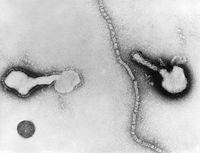Parainfluenza virus
| Human Parainfluenza Virus | ||
|---|---|---|
 | ||
| Virus classification | ||
|
Description and significance
Upper and lower respiratory tract diseases in humans are mostly caused by Human parainfluenze viruses and as a group are called “parainfluenza.” Human parainfluenza viruses (HPIVs) are the second to the respiratory syntial virus (RSV) as a common cause of upper and lower respiratory tract infections especially in infants and young children. [1] It is less common among adults. Paramyxoviruses belong to Paramyxoviridae family of Mononegavirales order which are negative sense single stranded RNA (-ssRNA) viruses responsible for many diseases in humans and animals. Negative sense RNA first of all makes positive sense RNA through copying their genomes by RNA polymerase. The positive sense RNA molecule is translated into proteins acting as viral mRNA. Thus more –ssRNA are produced when the resultant proteins directs the synthesis of new virions such as capsid proteins and RNA repilcases. [2]
Genome structure
Cell structure and metabolism
The Human Parainfluenza Viruses are consist of a nulceocapsid and an envelope with an average diameter of 120-300 nm. The nucleocapsid is a tubelike structure with helical symmetry and 12-18 nm in width. It contains a –ssRNA molecule with 5-8*10^6 molecular weight, the phoshphopritein P, the major nucleoprotein NP and the RNA polymerase L protein. The L proteins is necessary for viral transcription, P proteins takes part in RNA synthesis and NP helps to maintain the genome structure. The envelope is a double layered membrane. The outer layer is covered with spikes which consist of lipoproteins and glycoproteins whereas the inner layer contains non glycosylated matrix protein M. The spikes’s glycoproteins contain hemagglutinin neuraminidase HN and the cell fusion protein F. Hemagglutinin attaches the virus to the host cell’s neuraninic acid receptor and F Protein makes the cleavage through which virus genome is penetrated into the host cell. [3]
Ecology
Pathology
Application to Biotechnology
Current Research
References
Be sure to replace "Needs" in "Needs Workgroup" below with a workgroup name. See the "Workgroups" link on the left for a list of workgroups.